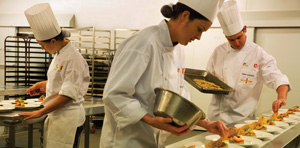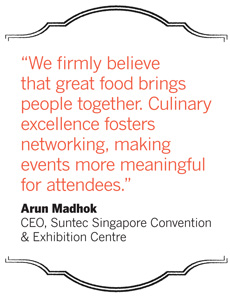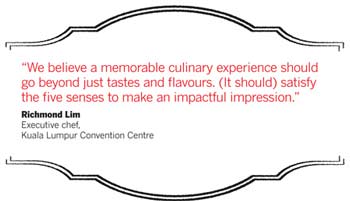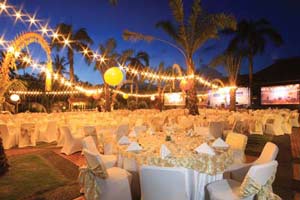As more dining functions become an integral part of the complete business event, convention centres must perfect their F&B operations to satiate demanding organisers. We find out what the new needs are and which centres in Asia are muscling up their culinary creativity and catering prowess
By Karen Yue, Rebecca Elliott, Paige Lee Pei Qi, S Puvaneswary, Mimi Hudoyo, Rosa Ocampo, Prudence Lui
 Convention centres have for years now recognised the need to be more than a provider of event space. The more competitive ones of the lot have invested in technology to enhance event organisers’ delivery of events and delegates’ experience, in sustainable capabilities to reduce their impact on the environment they operate in and at the same time, satisfy a growing number of clients who prefer to work with green partners, and in building an in-house team of event specialists who can add another dimension of operational support for their clients, among other areas.
Convention centres have for years now recognised the need to be more than a provider of event space. The more competitive ones of the lot have invested in technology to enhance event organisers’ delivery of events and delegates’ experience, in sustainable capabilities to reduce their impact on the environment they operate in and at the same time, satisfy a growing number of clients who prefer to work with green partners, and in building an in-house team of event specialists who can add another dimension of operational support for their clients, among other areas.
These days, convention centres in Asia are sharpening yet another aspect of their service delivery – food and beverage.
Bruce Winton, general manager of the new Marriott Grand Ballroom (MGB), a convention centre that opened last year which has already earned a reputation for being one of the Philippines’ largest convention venue for up to 5,000 pax, said this evolution is necessary for convention centres to do well going forward.
“In this age, organisers favour one-stop-shop kind of venues that hotels have an advantage in. Gone are the days that a function room will be offered bare; requirements are now built-in. Organisers’ considerations are highly dependent on the venue’s completeness against their checklist. Innovation is top of mind when it comes to catering, lighting and sound equipment, event coordination, room accommodation, etc,” remarked Winton.
It is this need for a complete service that renders a basic catering service at convention centres obsolete today.
Convention centre chiefs opined that the new importance placed on quality dining functions within a larger business event stemmed from organisers’ need to deliver a strong and memorable overall experience for their delegates.
Renato Padilla, general manager of Philippine International Convention Centre (PICC) in Manila, said: “With the goal of mounting uniquely creative and memorable events, organisers and clients are more demanding in terms of the quality and variety of food and service.”
“Even corporate functions are becoming themed events. We have to be prepared with an inventory of chairs, linens, flatware and décor to match the clients’ desired theme. On certain occasions, even the food servers have to dress to the theme,” added Padilla.
Food is now an “integral part of events” and not just a secondary consideration for event organisers, according to Arun Madhok, CEO of Suntec Singapore Convention & Exhibition Centre.
 “Event attendees have come to expect good food and organisers are looking past traditional catering (to focus on) innovative experiential dining concepts to complement their event themes,” Madhok remarked.
“Event attendees have come to expect good food and organisers are looking past traditional catering (to focus on) innovative experiential dining concepts to complement their event themes,” Madhok remarked.
Adelaide Convention Centre CEO, Alec Gilbert, agree. “Planners are aware that food and beverage can be the maker or breaker of large-scale events, and the importance of getting it right and providing a unique experience is paramount,” he said.
A taste of the destination

Adelaide Convention Centre has been seeing an uptick in requests for customised menus and a need for menu design to be themed, often based on the uniqueness of local produce.
Gilbert said: “When (event guests) taste our food, it may be the first opportunity they have had to taste the produce and wines from South Australia. As a centre, we provide the window to what the state has to offer, and therefore it is important that we do it right. Guests are looking beyond the menu and wanting to learn something about the food, culture and traditions of the host destination.”
Suntec Singapore’s Madhok has also noticed a growing appetite for local favourites during dining events.
 “We see an increasing demand for menus with a local flavour, for delegates who may not be able to experience the local culture due to their tight schedule (during the event period),” he said, adding that the centre is able to include traditional teh tarik (pulled milk tea), for instance, in the menu at clients’ request.
“We see an increasing demand for menus with a local flavour, for delegates who may not be able to experience the local culture due to their tight schedule (during the event period),” he said, adding that the centre is able to include traditional teh tarik (pulled milk tea), for instance, in the menu at clients’ request.
Colin Yeoh, group director of food & beverage operations, Sunway Hotels & Resorts Malaysia, which manages the Sunway Pyramid Convention Centre within the Sunway Resort City, noted that requests from event organisers to “feature and prepare local cuisine and present it in novel and creative ways” are on the rise.
“Their intention is to showcase the diversity in Malaysian cuisine and to create unique experiences for their delegates during their short stay in Malaysia,” Yeoh said.
He added that Sunway’s diverse culinary team is also capable of creating “enticing menu selections with an array of Malaysian, regional Asian, Middle Eastern and Western cuisine that will take diners to a special place and time, one plate at a time”.
More servings of interaction please
Convenient dining options are in demand, discovered Marina Bay Sands’ (MBS) executive chef, Christopher Christie, as organisers and event delegates seek to pack more networking opportunities into the programme.
“As networking plays a pivotal role in every meeting, we see a growing demand for easy grab-and-go snack items that are convenient for meeting delegates,” Christie said.
To address this need, Christie and his team will set up themed pop-up cafes within the convention centre, an arrangement that allows delegates to network while filling their tummies.

Sharing the same observations, Adelaide Convention Centre’s Gilbert said “there is less of the three-course, sit-down menu and more techniques being employed in the menu designed to stimulate interaction among delegates”.
Besides connecting with one another, delegates at dining functions are also increasingly desiring interaction with the kitchen, found Peter Haycroft, executive chef at Melbourne Convention and Exhibition Centre (MCEC).
He said: “They are very interested in where their food as come from, how it is cooked and how it is served. This has led us to invest in live cooking stations.”
Diverse diets
Dining events at convention centres are becoming more complex, a change catalysed by an increasingly diverse event audience with different dietary requirements and preferences.
The kitchens of convention centres must now accommodate dietary preferences, not just dietary restrictions.
“Healthy options – as opposed to dietary requirements – will be very popular this year,” said MCEC’s Haycroft.
Kuala Lumpur Convention Centre Malaysia, which has been fielding more requests for healthy dishes and beverages, has started to include a wide selection of such options in its banquet menus, Day Conference Packages, TenOnCall offerings and public catering outlets (West Wing Café and Park View Deck), revealed executive chef, Richmond Lim.
In 2015, Adelaide Convention Centre introduced a new food philosophy: Soils and Seasons. It was designed to tell the story of South Australia’s farmers, fishers, growers and wine makers, which Gilbert said was helping to build the centre’s reputation around the world.
The new International Convention Centre Sydney (ICC Sydney) unveiled its own food philosophy too this February. Feeding your Performance promises to feed its event delegates fresh, healthy food to nourish the body and mind.
CEO Geoff Donaghy said executive chef Tony Panetta had worked with nutritionists and regional suppliers in New South Wales to develop an “industry-first approach to cuisine”.
The new food philosophy spans ICC Sydney’s retail outlets and events.
At PICC, requests for halal, kosher, vegetarian, gluten-free and nut-free meals “are not uncommon”, according to Padilla.
“As many events now have a diverse delegate profile, and lifestyle choices have evolved with the times, organisers now ask for a variety of meal choices that were not usually requested for in previous years,” said Padilla.

When the new Marriott Grand Ballroom was built, it included 15 kitchens to support each event space and to satisfy the growing need for quality food options of a wide-ranging variety. These kitchens are staffed by a multiracial culinary team to ensure authentic flavours. It will soon have a halal certified kitchen to support the increasing number of events from the Muslim community.
Besides requests for foods prepared with less cream and fat, some organisers are also enquiring about sustainable food options, noted Yasinta Hartawan, general manager-operations of Bali Nusa Dua Convention Center.
Celebrity status
The plethora of cooking TV shows and expansion of celebrity chef restaurants across the world are influencing how people dine and raising their expectations of dining events they attend.
Sharing his observations with TTGmice, Adelaide Convention Centre’s Gilbert, said: “Both clients and delegates are becoming far more discerning in terms of the quality and presentation of meals. Expectations are much higher and the lines between quality function catering and restaurant a la carte catering are blurring.”

Gilbert believes that the “prevalance of cooking shows on TV and the rise of celebrity chefs” are effecting these changes in dining function requirements, and noted that convention centres today must be proactive partners with the client in order to create a successful event.
Richmond Lim, executive chef at the Kuala Lumpur Convention Centre Malaysia, agrees, saying: “Some organisers want us to replicate the taste of dishes they personally like at fine dining restaurants for their banquet event.”

Lim added: “But it is not that simple to replicate because fine dining restaurants usually cook for 60 to 80 people, whereas banquet events at the centre may be for up to 6,000 pax for a sit-down dinner or 12,000 for a standing buffet. We have to be able to deliver food at the right speed, time and temperature.”
Varied venues
The quest for a spectacular dining experience is also impacting organisers’ choice of venue.
For convention centres that are part of an integrated development complete with hotels and attractions, such a request can be easily satisfied.
“There is a growing trend for organisers with more than two consecutive days of events at the centre to look for dining venues (elsewhere),” said Sunway’s Yeoh.
“With all our facilities, from the convention centre and three hotels with more than 1,400 (keys), to the theme park and Sunway Pyramid Shopping Mall – all within walking distance and linked by covered walkways – we are able to offer convenience and comfort to event organisers and take away the hassle of planning transportation for medium- and large-scale events,” said Yeoh.

Meetings have been hosted on Sunway Lagoon’s man-made beach and Sunway Pyramid Shopping Mall’s skating rink.
“Our F&B team always promote our hotel venues to clients (who desire alternative venues to convention centre ballrooms,” said Alexander Dietzsch, executive assistant manager food & beverage of The Westin Resort Nusa Dua Bali, which manages the Bali International Convention Centre next door.
“We have created customised packages for all our hotel venues, and they can cater for groups. We frequently have corporate groups joining our Sunday Brunch when their meetings fall over a weekend,” Dietzsch added.
Business events taking place at the Sands Expo and Convention Centre, part of the MBS integrated resort, can utilise the complex’s impressive collection of 10 celebrity chef restaurants.
Christie, said: “Our clients can choose to host their networking events over celebrity chef dine-arounds where guests can taste multiple award-winning flavours in a single night, or commission a celebrity chef to create a menu for a sit-down dinner.
“Our clients recognise that when they do an event at MBS, it is not just an event space or technical expertise that we can provide, but a holistic end-to-end experience which includes creating culinary magic when needed.”
For instance, as Christie explained, one of MBS’ specialities is themed dinners, which are easily done in ballrooms and staff are on hand to support world-class entertainment acts that clients increasingly bring in to jazz up their evenings.

“Having the option to dine poolside or at the lagoon at The Venetian Macao is as important as the food we offer,” remarked Gene Capuano, vice president of convention and exhibition operations.
To keep meeting groups on site, Bali Nusa Dua Convention Center, which is not part of a mixed-used complex, has resorted to pitching its public spaces. Taman Jepun, a courtyard between halls one and two, has become an ideal venue for a Balinese-themed dinner or reception.
“Its green surroundings, architecture and the Balinese gate make a dramatic backdrop for any event,” said Hartawan.
PICC chooses to take advantage of its vast grounds – a rarity in Manila – by adding a second outdoor venue, The Garden, to support afternoon and sundown gatherings. The Garden offers 2,946m2 of space with 47 plant species, park benches and a centrepiece koi pond. PICC’s other outdoor venue is The Courtyard, which can take 860 pax for a cocktail party.
Investments in technology
Several convention centres in Asia have spruced up their kitchen to better cater to the new breed of demanding dining events.
According to Lim, Kuala Lumpur Convention Centre has acquired a reputation for being able to deliver five-star banquets for large volumes of people, and that is due to the investments made in kitchen technology. The centre’s kitchen is now fitted with touchscreen ovens with USB ports and other upgraded equipment.
“It is important to keep up with kitchen technology as it will allow us to prepare food more efficiently. Productivity is very important in this business and something we strive for every day,” Lim said.
MBS’ kitchens – 48 in all – are equipped with “high quality culinary equipment such as combi-ovens, induction stoves and sous vide machines for precision cooking”, said Christie.
But more critical to the success of a banquet is the essence of timing, remarked Christie, especially when it comes to serving a hall filled with thousands of hungry people.
He pointed out that MBS’ dynamic team of 400 culinary staff and 120 banquet operations personnel is a key component for flawless execution.
Suntec Singapore modernised its three kitchens in 2015 with the installation of state-of-the-art ovens which allow its chefs to maintain a high food quality even when cooking in large quantities.

“All our gas stoves were also replaced with induction stoves, which is in line with our sustainability goals, and more importantly, they are safer for our chefs,” said Madhok.
PICC has recently invested in top-of-the-line kitchen equipment and in-house facilities with its exclusive caterer, Via Mare, one of the country’s foremost catering service provider with 40 years of experience under its belt.
How planners did it

A cultural lure
Pacific World Singapore organised a conference in Sands Expo and Convention Centre for 750 attendees from an international agricultural firm two years ago, and there was a three-hour gap between the conference and dinner. As the client wanted to contain all attendees in the venue before dinner, a few challenges surfaced.
Linda Low, manager of strategic partnership and product marketing, Pacific World Singapore, said: “It was difficult to find an appropriate holding area to adjourn the group to, and to keep them engaged during waiting period. Furthermore, there was a turnaround time of three hours to convert the room from conference set-up to a banquet setting.”
The decision was eventually made to use the foyer outside of the ballroom as a holding area for the attendees. This helped to minimise movement of the group.
To entertain them during the three-hour wait, Low said cultural activities were set up in booths placed around the foyer. These activities gave attendees a taste of Asian cultures and encouraged interaction at the same time. Hostesses were also dressed in costumes of different ethnic groups in Asia.
Low said: “While dinners in ballrooms are common, what was satisfying from the event was the pre-dinner interaction and cultural experiences which was the client’s objective.”
Themed for variety
The annual Philippine MICE Conference (MICECON) is the country’s largest MICE event and one that is aimed at showcasing the destination’s capability in hosting international events.
The edition in September 2015 made use of its various dining functions to inject excitement into the two-day conference, according to Tourism Promotions Board (TPB) chief of marketing and promotions, Susan del Mundo.
Working with the Marriott Grand Ballroom, the convention centre where MICECON was held, the TPB rolled out thematic coffee breaks, a 1960s themed lunch function and a colourful dinner party.
For the lunch event, cushions were strewn around low tables, and they were matched by gay buntings and other decorations typical of the Philippine fiesta. Participants were asked to come dressed in 1960s fashion, and entertainment echoed that era.
For the dinner party, an array of international food was served, including a huge vat of paella. There was also cheese, a tapas bar and other beautifully bedecked buffet stations. Cubic seats lit in various hues lend colour to the venue, and MGB utilised its 176 programmable pillar ceiling lights to enhance the ambience.
Delectable food that were creatively presented, excellent entertainment that is second nature to Filipinos, and dazzling lighting effects combined to make MICECON 2015 memorable and experiential, said del Mundo.
Convention centres get creative

Above: Streetmosphere performers inject fun to a Tupperware convention. Below from left: The Westin Resort Nusa Dua takes dining events onto the beach; Bali Nusa Dua Convention Centre executes a traditional dinner
Meetings under the sun
The Westin Resort Nusa Dua, which manages the Bali International Convention Centre next door, has played up its location in a sunny resort paradise by arranging meetings outside of the convention centre.
It had a meeting venue set up on the beachfront, with sun beds lined up to face the speaker. It also did a corporate gathering in a picnic set-up with blankets, cushions and well-stocked picnic baskets.
A promised beer garden
At the Professional Conference Organisers Association Conference in November 2015, the Adelaide Convention Centre used a beer garden concept to showcase increasingly popular craft beers from South Australia, collaborating with a range of local microbreweries. The concept changed the format of a traditional banquet and encourage more interactive among delegates.
Dine all over Australia in one location
During the Australian Tourism Exchange held at Melbourne Convention and Exhibition Centre in June 2015, it wasn’t just Melbourne’s cuisine the culinary team had to showcase to the 10,000 delegates from 38 countries over four days. In line with Tourism Australia’s Restaurant Australia campaign, the food and beverage offering illustrated the unique cuisines of each state and territory, with produce flown in from all over Australia.
The centre’s chefs and procurement team worked closely with each state’s tourism authority to not only source and order produce from their region, but also develop creative menus for eight concurrent cocktail functions.
A feast for all senses
A private New Year’s Eve event held last year at the Grand Ballroom in Sands Expo and Convention Centre in Singapore saw a lavish sit-down dinner for more than 2,000 guests. Apart from platters of seafood served, guests were also treated to a cheese and chocolate buffet at the Grand Ballroom foyer while they watched fireworks through the towering glass façade.
An international affair
A Tupperware convention at The Venetian Macao Cotai Expo required the venue to provide its 8,000 guests with eight different menus to showcase eight different cultures including Macanese, Chinese, Korean, Japanese, Singaporean, Thai and Indian (both vegetarian and Jain). Some 800 tables were spread out over 40,000m2 of exhibition hall space, and country flags were flown over each area to identify the different dining speciality. Colours LEDs to light up pillars provided extra colour differentiation for the various areas.
For entertainment, The Venetian brought in Steetmosphere roaming performers and singing gondoliers.
A local touch
The Kompas Gramedia Dinner for Asia Pacific Media Forum 2014 held at Bali Nusa Dua Convention Center was executed in Lesehan style, an informal Javanese concept which sees guests seated on the floor at low tables. Food stalls were set up around the event space.






















